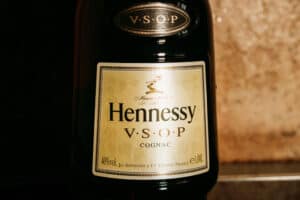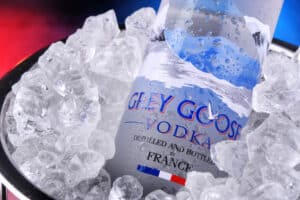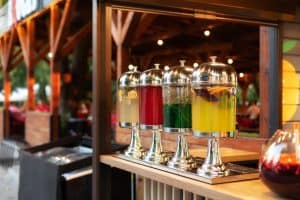
Creating your own cocktail is a neat way of expressing creativity and a great way to show off your mixology talents. The elements of a cocktail are like baking a cake or a pie: each ingredient plays a part, and when one is out of sync with the rest, the whole recipe is a flop.
Creating your cocktail for a special event is part of the fun, and tinkering with classic cocktails is a tasty experiment. It isn’t rocket science either; you don’t have to go and hunt down obscure and expensive bottles of alcohol either—an adventurous spirit and willingness to explore are all you need to create your cocktail.
To make a great cocktail, engage your senses by choosing ingredients that look good, smell appealing, and have a balanced taste. The key is to be selective with your base spirit and make sure it complements other ingredients to create a harmonious taste. Experimentation is the key to finding your own signature drink.
We’ll be going on a taste journey unlike any other in this post. We’ll begin with tips on engaging the senses because drinking cocktails is a multi-sensory experience. Your choice of base liquor is also essential because it will both limit and give you the freedom to explore. We also have some tips on balancing the taste of your cocktail.
Where To Begin
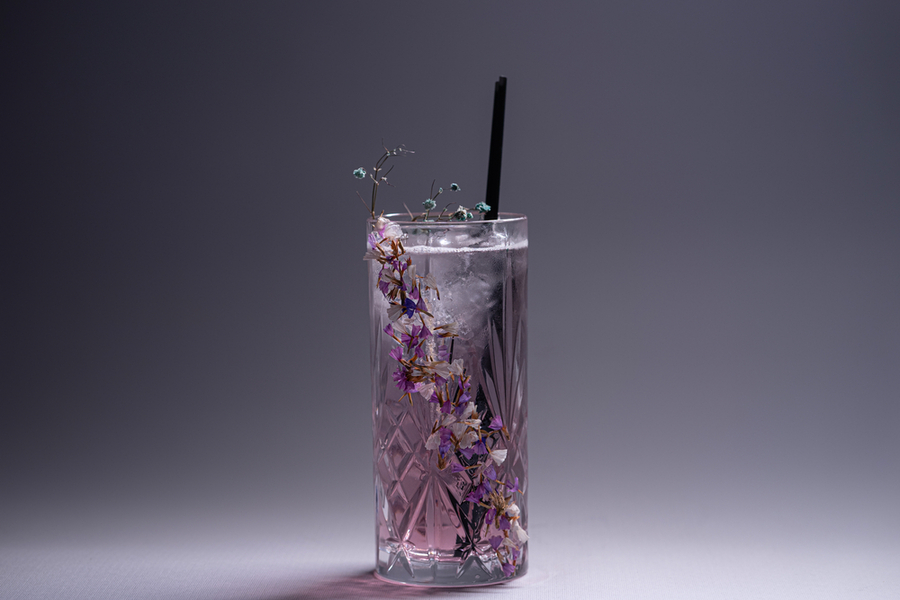
Before you get crafty in the bar or kitchen, think about your needs and the end goal when you design your own cocktail.
Here are some questions you can think about before you set out to create your own cocktail:
- Is there a specific liquor you want to use, such as whiskey, brandy, gin, rum, tequila, or vodka?
- The base liquor will influence the final product. What’s the purpose of your drink—is it for a wedding reception, dinner party, cocktail hour, or a special event?
- Is the liquor forming the base and giving your drink an alcoholic kick, or is it the star and focus of your creation?
Let’s unpack these questions to guide you through creating a unique cocktail.
1. Engage the Senses
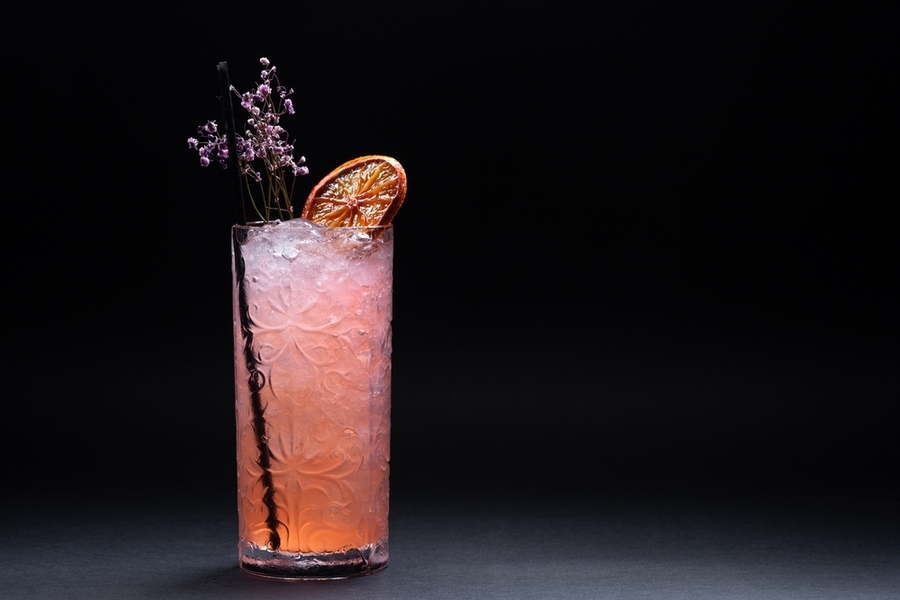
Before we start, let’s clarify two terms usually used when describing cocktails: flavor and taste.
- Flavor: also called aroma, is primarily experienced through the nose. Think of citrus—you smell an orange long before you’ve tasted it. The same goes for cocktails; the smell or aroma of your cocktail is an essential factor. When something smells good, we’re more likely to drink it.
- Taste: is experienced on the tongue and the mouth. These basic tastes play a role when designing a cocktail: sour, sweet, bitter, smokey, or herbaceous all play a role when preparing your signature drink for a party or wedding reception. If you’re going to serve deathly sweet saccharine cocktails, most people won’t like them (although you and your partner might); the same goes for an overly sour drink that knocks your taste buds in overdrive. Balance is vital, as we’ll discuss a bit later.
Apart from flavor and taste, there’s a third category: visual. A lime-green cocktail mixed with Midori melon liqueur looks really interesting. It offers a refreshing move away from pink drinks. What would Whiskey Sour be without foam on top?
2. Choosing Your Liquor
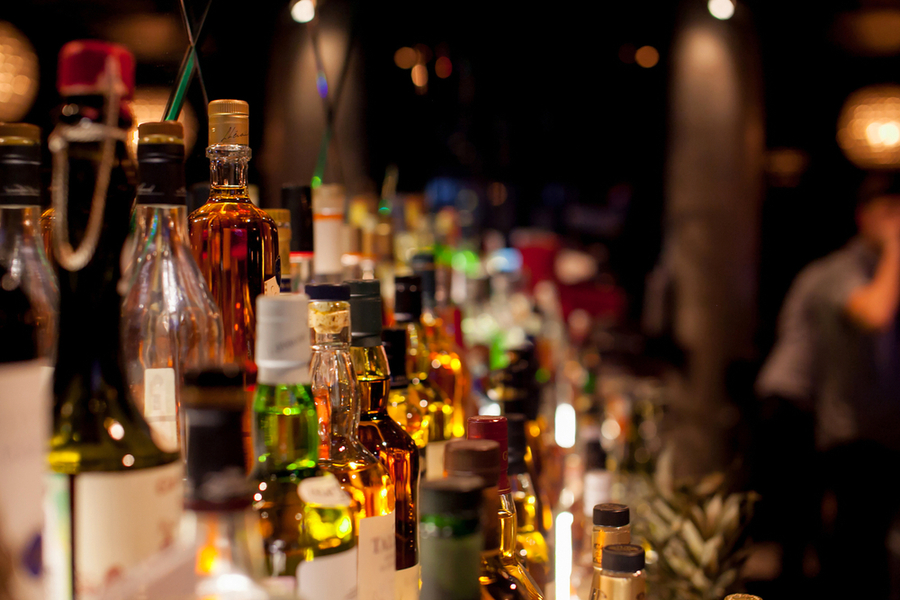
As we’ve just mentioned above, you need to decide what your base liquor will be. As humans, we aren’t hardwired to like the harsh taste of spirits.
Additionally, our survival-orientated brains ‘warn’ us, through a burning sensation, that we’re probably consuming something terrible for us—hence the alcohol burn.
We’ll briefly examine the chief characteristics of the base alcohol you’ll need to know when mixing up cocktails. So, let’s dive in!
Whisk(e)y
Many great cocktails can be based on a whiskey base—some where the whiskey is the primary focus, others where the whiskey plays nicely with the other ingredients to provide a harmonious whole.
Whisk(e)y also offers you a whole world of flavors, from sweet, vanilla notes (notably bourbon and some Canadian whiskies) to spicy tastes (especially rye) to bitter and smokey (malted Scotch).
Whiskey makes the perfect base for a whole range of cocktails.
Vodka
Vodka’s subtle flavor makes it the popular kid on the block everyone wants to play with after school. Metaphors aside, vodka mixes well with almost any other spirit or liqueur.
Vodka is a great starting point if you’re trying to mix up a boozy cocktail, something that’s easy to drink, or even a cocktail that requires a fair amount of other ingredients.
Gin
This is one of the most versatile ingredients you’ll encounter after vodka. But, unlike vodka, there are a few categories within the gin family, which you can read about here.
Rum
Rum isn’t reserved for pirates or tiki parties. These days rum can be as complex as whiskey, with numerous categories, flavor profiles, and even infusions.
Rum is also the perfect spirit for experimenting if you’re trying to build your own cocktail—start small and substitute the base spirit in your favorite cocktail with rum. Usually, two- or three-ingredient cocktail recipes are an excellent place to start.
Tequila (and Mezcal)
Tequila is so much more than just an ingredient for Margaritas.
Tequila adds an earthy and herbaceous element to cocktails. Modern pairings include elderflower (usually associated with gin), sherry, and various liqueurs such as pink grapefruit (pamplemousse), gentian, and lavender, to name a few options.
Mezcal has a smokey taste and can be made from any of 40 different varieties of agave plants. In contrast, tequila may only be made from Weber’s agave (agave tequilana).
All tequila is part of the mezcal family, but not all mezcal is tequila.
Cognac and Brandy
All cognacs are brandy, but not all brandies are cognacs.
Brandy can be made from any fruit juice and is essentially distilled fruit juice. Brandy is also sweet-tasting and hovers between 90 and 100 proofs (45–50% ABV).
Cognac is very particular: it comes from the Cognac region in the southwest of France (Charente), and it has to be made from one of six types of grapes from six specified terroirs. The main grape is usually ugni blanc.
Distillation is done in two separate rounds: generally in October or November, and all distillation must stop on 31 March. Cognac still presents the taste of the grapes and is an excellent replacement for vodka in cocktails.
If you need help, here’s an excellent flowchart to help you categorize the base spirits into boozy and refreshing categories. The dashed lines show cocktail families and how you can swap out certain ingredients to create a new cocktail.
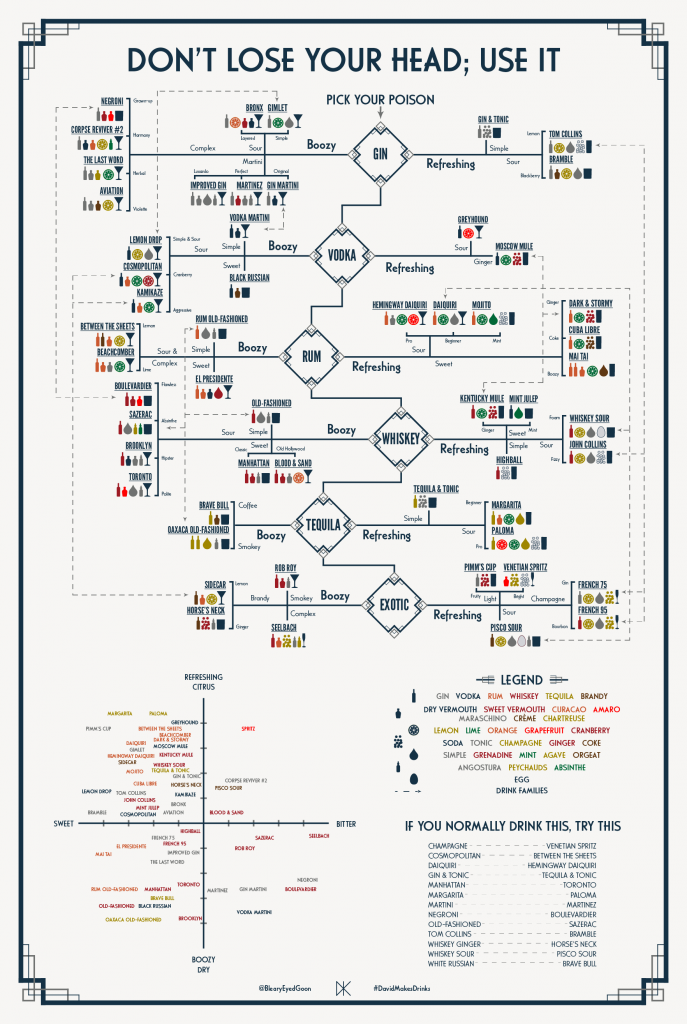
If you’re still stuck for inspiration, why not take a peek at this cheat sheet to see what works with the four main base spirits: gin, rum, tequila, and whiskey.
3. Creating Balance
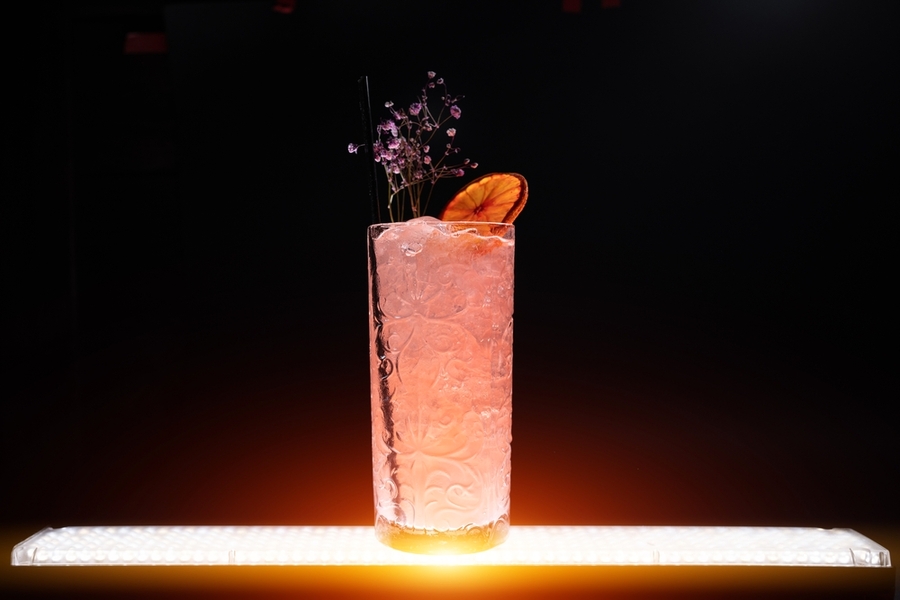
The key to a fabulous cocktail is balance. You can either balance the base spirit’s strong taste by tempering it or making it shine. Let’s start with balancing a cocktail.
The basic formula for creating a cocktail is 2:1:1, where you’ll use two parts base spirit, one part sweetening, and one part souring agent.
For an easy cocktail, you’ll select your base spirit, say whiskey; add a simple or infused syrup (here’s a great guide) and a souring agent such as lemon, lime, or grapefruit juice. There you have it, a simple yet tasty cocktail.
But cocktails are more than just a spirit and something sweet balanced out by something sour. They can be complex creations too. One way to tell whether your new composition is balanced is to check the taste.
An overpowering sweetness or acidity is a sign that you’ll need to adjust your recipe. When adjusting doesn’t do the trick, you can introduce a bridging element, such as a liqueur.
According to Difford’s Guide, there are ten base liqueurs to make over 150 classic cocktails. Monin Pure Cane (sugar syrup). A pinch of salt may help to balance out harsher flavors and bring taste forward.
Ultimately, you need to understand the six essential ‘mother recipes’ for cocktails to see how each element is combined to create a classic cocktail. Click on this link and scroll down to the schematics, showing you the mother cocktail and the derivatives.
4. Serve Your Cocktail Right

You’ll never serve a Martini in a rock glass, just like you’d never do a mint julep in a stemmed cocktail glass. Choosing the right glass for your cocktail is essential from a visual and serving standpoint.
Here’s a quick primer on the different glasses:
- Highball glasses: hold between eight and sixteen ounces and are used for drinks that are made directly in the glass and always served on the rocks.
- Collins glasses: are similar to the highball but tapered inwards at the top. Traditionally, mixed drinks are served in a Collins glass on the rocks.
- An old fashioned or rock glass: is what you’ll use when you’re not using many mixers or want to serve a drink neat or on the rocks.
- The martini or cocktail glass: holds three to six ounces of liquid, almost always stemming from preventing heat from accidentally heating your drink from your hand.
- The coupe glass: is similar to the martini glass and typically holds four ounces of tipple. You can use this glass to serve a wide variety of classic cocktails and your own creations.
What if I Lack Inspiration?
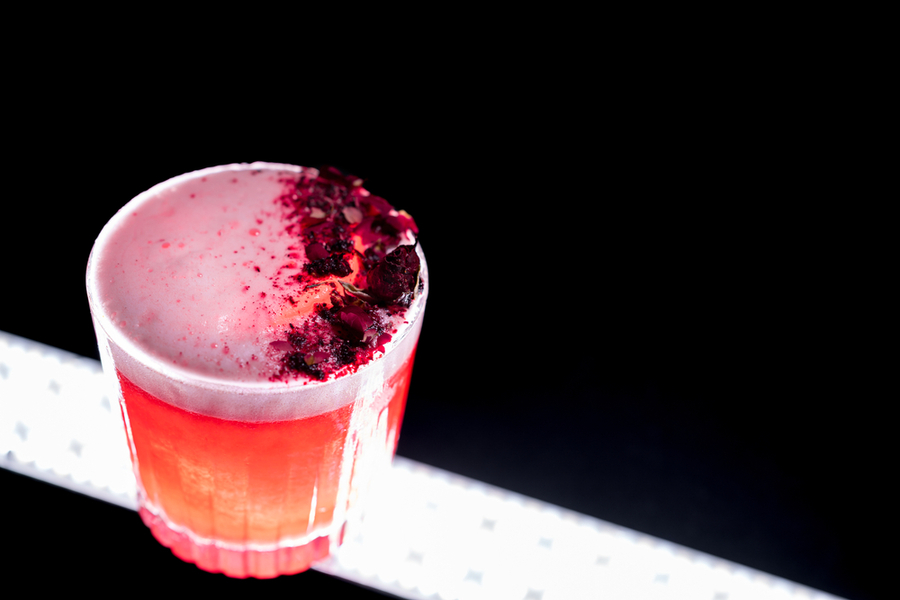
Suppose you and the cocktail muses are having trouble communicating. In that case, you can always turn your attention to a flowchart or a book.
We love discovering new cocktail books, and while there are many great ones on the market, the below caught our attention.
These options aren’t designed to help you build a new cocktail but rather to help you understand how cocktails are constructed, and the ratios bartenders have used to make fabulous cocktails in the past.
These books are orientated to offer you visual guidance in the form of diagrams, flowcharts, and grids—luckily, not the boring kind you encounter at the office.
Once you understand your favorite and classic cocktails, we feel you’ll become a better home mixologist because you’re armed with knowledge (and hopefully some new and exciting spirits on your shelf).
Let’s quickly look at the three options below.
1. Cocktail Codex: Fundamentals, Formulas, Evolutions
The latest book from Death & Co, NYC, is organized around cocktail families in the form of visuals rather than diagrams. The starting point is a root recipe, and the variations on that drink are like a flower opening—variations are presented to show how cocktails share similar traits and how they differ.
Instead of memorizing a bunch of recipes, the book will empower you to understand why variations and formulas work. The book’s premise is built on six well-known templates covering base spirits:
- Old Fashioned (whiskey)
- Martini (gin or vodka)
- Daiquiri (rum)
- Sidecar (cognac or brandy)
- Highball (whiskey, again)
- Flip (whiskey, once more)
We’d like to add a seventh base spirit, tequila, as seen in the Margarita.
Available to purchase here.
2. Be Your Own Bartender: A Surefire Guide to Finding (and Making) Your Perfect Cocktail
The perfect tool for the home mixologist who doesn’t want to panic when they have to page through a recipe book and get overwhelmed by all the options.
Think of the book as one of those Choose Your Own Adventure books where you are led to a final resolution for your adventure. This time, you won’t be swallowed whole by some kind of monster—you’ll end up with a fantastic cocktail! Guaranteed to work every time.
The book’s flowcharts were inspired by the bartender asking customers questions when they want an off-menu cocktail. Before you get put off the idea of flowcharts, these are not the run-of-the-mill PowerPoint presentations that bore you rigid at corporate meetings.
They’re whimsical and fun to use. You can read more about the book here, or if you want to dive in and purchase your copy, follow this link.
If you’re hosting a cocktail party, follow the advice locked up in this tongue-in-the-cheek flowchart to guide you on the type of cocktails you might want to serve (it is based on advice on business after-work drinks in various scenarios, but can be helpful just in case colleagues come over).
Also, who said flowcharts couldn’t be fun?
3. The Joy of Mixology, Revised & Updated Edition
This book was first published in 2003 and contained a series of grids that grouped and mapped cocktail families. The book’s purpose is to streamline choosing and memorizing cocktails.
Compared to the first edition, the new edition omits several obscure categories like eleven drinks based on crème de noyaux liqueur. While the layout resembles the dreaded Excel spreadsheet, it is still user-friendly. You can purchase your copy here.
We’ll admit these books feature existing cocktail recipes. Still, they can help you understand cocktails better and guide you on how to design your cocktail.
Final Tips and Tricks
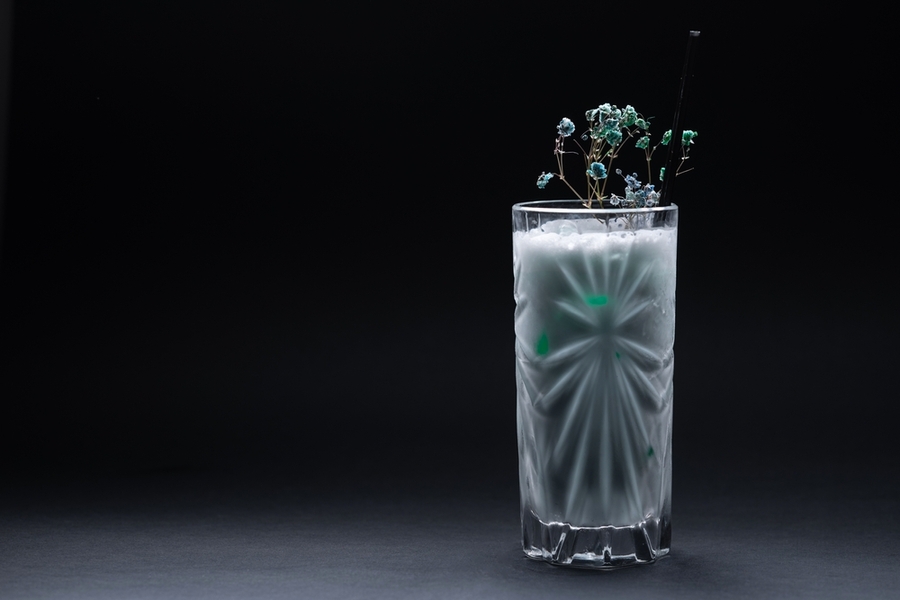
Before you decide on a signature, self-created cocktail for your wedding party or special event, run your cocktail through these tips and tricks. After all, the final verdict lies in the visual appeal, aroma, and taste—you want to give guests something to remember, not abandon after two sips…
- Give the recipe to someone else to make—can they replicate your recipe and come up with the exact same taste using the exact same ingredients as you?
- Let your cocktail rest for 15 minutes. Most cocktails are best enjoyed as soon as they are served, but in reality, people aren’t going to gulp down a cocktail the moment you present it to them.
- Does it taste the same as when you’ve poured it?
- Did the flavors combine harmoniously, or is the cocktail out of balance?
- Is an ingredient overpowering the others, or is an ingredient faded into the background?
- When you’re in doubt, add more of an ingredient than you usually would. This ties in with the questions we posed in the point above. Once you know how far you can push a cocktail, you will know what not to do (try not to overdo it with your expensive spirits or liqueurs because this will make you sad, and you’re wasting good alcohol).
- Is it a shaken or stirred cocktail? Are you muddling ingredients in a glass before you build your cocktail? Are you serving at room temperature, or will all the components be cooled down in a shaker and then strained into a glass?
- When you’re happy with your signature cocktail but feel it lacks something ‘extra,’ try adding a dash of bitters—one or two drops at a time.
- Have fun! Mixology is about discovering new combinations you thought were taboo, but that might work perfectly for you.
- Write down or record everything you do while experimenting—this way, you can check your notes and see what was good, what didn’t work, and what to avoid altogether.
- Learn some essential cocktail recipes by heart; we’d suggest starting with the six basic mother cocktails—from here on, you can begin substituting ingredients to your liking while discovering fresh new twists on old favorites.
Conclusion
Creating your own cocktail is two parts willingness to experiment, one part creativity, and one part diligence. Suppose you’re willing to experiment and drink some (sometimes bad) cocktails until you’ve found your special cocktail, the world’s your oyster.
Remember, hope is not lost if your creation doesn’t taste perfect off the bat—it takes practice and patience to create a cocktail that suits your palate perfectly.
We hope you’ll have loads of fun while experimenting and remember to write down your recipe when you’ve found The One.



